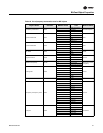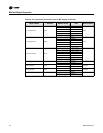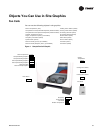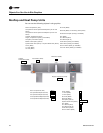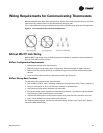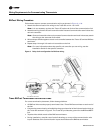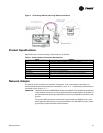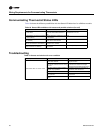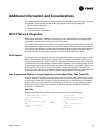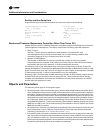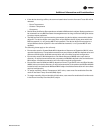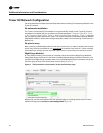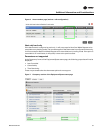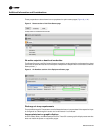
BAS-SVP10A-EN 29
Additional Information and Considerations
This chapter explainssome special tips and considerationsthat apply to theTrane Communicating
Thermostats. These tips and considerations are grouped in the following categories:
• MS/TP network integration
• Objects and parameters
• Tracer SC network configuration
MS/TP Network Integration
Before doing any BACnet integration, make sure to have Trane PICS (Protocol Implementation
Conformance Statement). This PICS document lists all the BACnet Services and Object types
supported by a device and can be found on the Trane portal.
The Trane Communicating Thermostats do not support the Change of Value (COV) service. COV
reporting allows an object to send out notices when its Present-Value property is incremented by
a pre-defined value. Since this is not supported at the thermostat, you should pay special attention
to the polling time settings at the Supervisory Controller and Workstation level when using a
graphical interface or an application program to read or write to the BACnet objects.
Site Graphics
For example, some site graphics might poll every data item linked to the graphic page on a COV
basis. If the third party device does not support COV, the graphic interface then relies on a pre-
configured polling interval, which is usually in hundredths of milliseconds. Any device containing
a monitored object could be subject to network traffic congestion if such a polling interval is used.
Trane strongly recommends a polling interval of 5 seconds or more for any graphic interface. This
becomes even more critical in area graphics where a single representation might poll many
devices. If proper poll rate is not respected, devices may be reported offline by certain front ends
by saturating the traffic handling capacity of BACnet MS/TP without COV subscription.
Free Programmed Objects or Loops (Supervisory Controllers Other Than Tracer SC)
As for the application program, you might want to read and write any MS/TP data on an “If Once”
basis ora “Do Every”loop basisinstead of readingor writingto a thirdparty device’sobject directly
in the program. Otherwise, any read or write request will occur at the Supervisory Controller’s
program scan rate, which might be in hundredths of milliseconds. This can easily bog down a
network as single commands can be sent to all ASC devices down the MS/TP trunks every
hundredth of a millisecond.
Fan Coils
Programs writing to the devices should have a structure similar to the following:
If Once Schedule = On then
MV13 = Occupied
End If
If Once Schedule = Off
Then
MV13 = Unoccupied
End If
OR
Do Every 5min
If Schedule = On Then
MV13= Occupied
Else
MV13 = Unoccupied
End If
End Do



